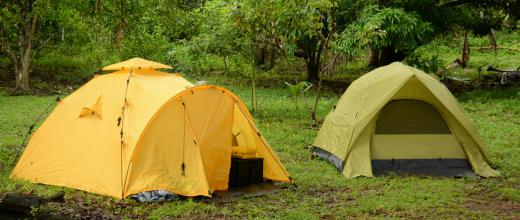Tent stakes are nearly as important as the tent itself. Today’s tents are often designed to withstand the elements, keeping occupants protected from changes in weather. However, they are not built to stand up against much wind. As such, tent stakes are vital for keeping your tent where you want it - on the ground.
Tent stakes may be made of plastic, metal, or wood. Each type is designed for use in certain types of terrain. For example, small diameter titanium stakes are designed for use in hard dirt. They should not be used when pitching a tent on sand or for snow camping.

Another type of tent stake, bulky angle iron/aluminum stakes, are useful for camping in the sand. This type of stake, however, is far from effective for use in hard dirt. Furthermore, these tent stakes are known to lose their effectiveness in rainy conditions.
Large plastic tent stakes are often used for family camping. These tent stakes are both lightweight and tough, featuring a large head for easier pounding into the ground. These stakes are less expensive than many other types. Keep in mind that exposure to ultraviolet light may degrade plastic stakes.
Skewer tent stakes are lightweight and inexpensive. They are straight in shape and are not the best option when holding power is vital. Generally speaking, skewer stakes work the best in grassy terrain. By contrast, bulldog tent stakes are heavier and more capable of holding fast. They don’t bend easily and work well in a variety of ground types.
Snow stakes are designed to be buried sideways in the snow. These stakes are stronger than those designed for general use. Some anchor stakes are designed for use in both snow and sand. They are made to be filled with snow or sand and buried in the ground.
Pigtails can be used in sand or soft snow. These tent stakes resemble corkscrews that have been opened or partially unwound. They are designed to be twisted in and out.
Wooden tent stakes are frequently used for securing group tents. They are generally thick and have a higher level of holding power than other types. Typically, wooden tent stakes are driven into the ground using a mallet.
You can even find glow-in-the-dark tent stakes that glow throughout the night. These tent stakes are useful for preventing tripping accidents. They are also good for setting up camp during the night.
